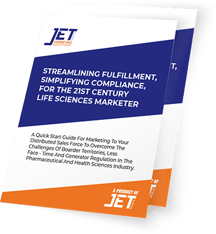Despite new industry regulations like the Sunshine Act, marketing to healthcare professionals (HCPs) has never been an easy process. On top of busy schedules and their high pressure jobs, it has been difficult to know their media consumption habits and which communications channels HCPs are most likely to prefer. In this article, we'll take a statistical look at how (and why) healthcare professionals consume marketing messages from your distributed sales reps.
For context, these have included traditional print publications (such as medical journals, direct mail, and newsletters), computer-delivered Internet content, mobile and tablet media, personal interactions with colleagues and peers across various venues including meetings and conventions, and both face-to-face and virtual interaction with representatives of pharmaceutical and medical device companies.
In the world of digital, one may be inclined to believe that new media (like email) trumps the tried-and-true methods of traditional marketing channels (like direct mail and printed communications) when it comes to building relationships with doctors and other healthcare professionals. However, recent studies suggest otherwise. In fact, pharmaceutical, biologic, medical device, and medical supply companies routinely report superior results when their sales efforts are boosted by printed promotional material and marketing collateral.
The Internet is truly a powerful tool, but it is hardly the only way to market to physicians. If you are wondering how to market to healthcare providers effectively, keep these surprising statistics in mind.
1. Not Every Doctor Prefers Email Over Direct Mail Marketing
In a 2012 survey conducted by the CMI/Compass Media Group, 66% of HCPs did express a preference for receiving information through email. While that number is significant, it means that a full third of all doctors would rather receive marketing information presented in some other way.
Moreover, keep in mind that for the healthcare vertical, on average, each email will likely experience a mere 18.7% open rate, which measures the number of opens as a percentage of total messages delivered. Email is a powerful tool, but it certainly will not reach everyone.
2. Many Doctors Actually Prefer Direct Mail to Learn About Your Products
In that same 2012 survey, nearly as many healthcare professionals also expressed a preference for receiving information through direct mail. As many as 65% of respondents had reported that this channel was their preferred means to learn about new products and services. It is a reliable bet that these doctors all have email addresses, but they would still rather get information in their physical mail box.
3. Interest in Direct Mail Has Staged a Substantial Comeback
One of the most revealing findings from that 2012 study was how significantly interest in direct mail has continually grown over the last few years. When the same survey was conducted in 2009, only 38% of respondents expressed a preference for receiving information via direct mail – that's compared to 65% preference in 2012.
How do we account for the 27% increase that has happened in just four years? It likely has to do with crowded email inboxes, ballooning social media accounts, and the near constant bombardment of information on the Internet. Printed marketing collateral is an efficient and direct way to cut through the clutter found in cyberspace.
4. Physician Assistants Personally Read Direct Mail Each Day
In another 2012 study, physician assistants (PAs) were surveyed to evaluate their preferred information delivery method. Direct mail ranked second only to email, beating out telemarketing, print media advertising and television commercials. When asked if they personally read mail from life science companies, 60% of the respondents reported yes. Clearly, direct mail is an effective way to educate the healthcare professionals who matter most.
5. The Overwhelming Majority of Nurse Practitioners Read Your Direct Mail
Nurse practitioners (NPs) were also included in this survey. An astounding 77% reported that they personally read pharmaceutical and life science information that arrives through the mail. With over 150,000 NPs licensed to practice in the U.S., any marketer looking to collectively appeal to this group would be well served by using direct mail and printed marketing collateral. Significant numbers of nurse practitioners are scouring the mail for useful information rather than casting aside catalogs, brochures, and postcards as simply junk mail.
HCPs are going back to the basics. Although email has been the preferred channel in recent years, direct mail has grown last year to become its rival, owning 65% of the professional healthcare provider audience. Whether it has to do with channel saturation, information overload, human mobility, or a combination of all, this shift cannot be overlooked. Simply put, when it comes to receiving important product information that can help doctors help more patients, more and more doctors are adding a heavier weighting to underutilized, basic, high-access information delivery channels such as direct mail to some of their existing and possibly more saturated higher-tech media preferences.
Printed marketing collateral is still an integral part of the marketing mix for pharmaceutical, biologic, medical device, and medical supply companies. And with new advancements making direct mail and marketing fulfillment for your distributed sales force faster, more efficient, and more economical than ever, there is no reason not to adopt a strategy.
To learn more about how to enhance your life sciences sales and marketing, download our free guide for Streamlining Fulfillment, Simplifying Compliance and Staying Competitive for the 21st Century Life Sciences Marketer.





COMMENTS